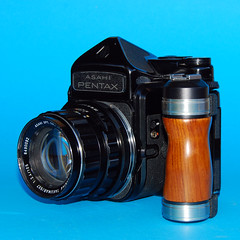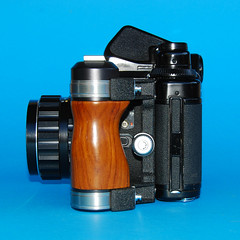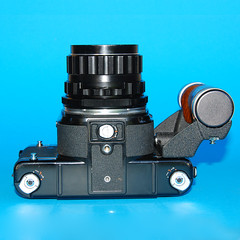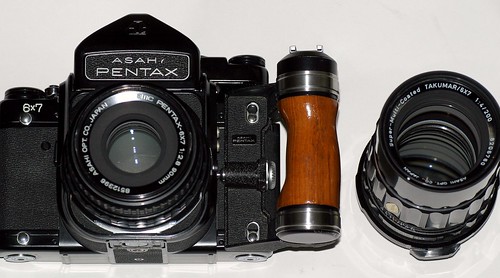Difference between revisions of "Pentax 67"
(replaced a broke image with a clean one and added images) |
Rebollo fr (talk | contribs) (picture layout, restored a picture whose link had changed) |
||
| Line 1: | Line 1: | ||
| − | {{Japanese medium format SLR|image=[http://www.flickr.com/photos/heritagefutures/4628416120/in/pool-camerapedia http://farm4.static.flickr.com/3325/4628416120_0c5ca789fa.jpg]<br/>Camera with accessory grip. Image by Dirk HR Spennemann {{with permission}}}} | + | {{Japanese medium format SLR |
| + | |image=[http://www.flickr.com/photos/heritagefutures/4628416120/in/pool-camerapedia http://farm4.static.flickr.com/3325/4628416120_0c5ca789fa.jpg]<br/>''Camera with accessory grip. Image by Dirk HR Spennemann {{with permission}}'' | ||
| + | }} | ||
The '''Pentax 6×7''', and later the '''Pentax 67''', are streamlined medium format camera systems consisting of the camera body, an interchangeable prism viewfinder and one or more lenses. A standard Pentax 6×7 outfit typically includes a non-metered pentaprism and a Super Takumar 105mm f/2.4 lens. A wide range of fixed focal length and zoom lenses, along with TTL-metered and other finders, were available as additional accessories. It is sometimes referred to as the P67 in online discussions and forums. | The '''Pentax 6×7''', and later the '''Pentax 67''', are streamlined medium format camera systems consisting of the camera body, an interchangeable prism viewfinder and one or more lenses. A standard Pentax 6×7 outfit typically includes a non-metered pentaprism and a Super Takumar 105mm f/2.4 lens. A wide range of fixed focal length and zoom lenses, along with TTL-metered and other finders, were available as additional accessories. It is sometimes referred to as the P67 in online discussions and forums. | ||
| Line 11: | Line 13: | ||
Some most impressive optics makes up the lenses available for this camera including range of leaf shuttered ones, satisfying flash sync requirements and solving mirror and shutter vibration problems. Half way through its production life the vibration problem was lessened by introducing a mirror lock-up feature in 1976. Sliding a switch on the right hand side of the mirror housing upwards releases the mirror. While a small flush button located under the numeral 7 in the model name on the right-hand front helps completing the mirror/shutter cycle if released without battery power; after depressing it with a ballpoint, press the shutter once more to complete the cycle. | Some most impressive optics makes up the lenses available for this camera including range of leaf shuttered ones, satisfying flash sync requirements and solving mirror and shutter vibration problems. Half way through its production life the vibration problem was lessened by introducing a mirror lock-up feature in 1976. Sliding a switch on the right hand side of the mirror housing upwards releases the mirror. While a small flush button located under the numeral 7 in the model name on the right-hand front helps completing the mirror/shutter cycle if released without battery power; after depressing it with a ballpoint, press the shutter once more to complete the cycle. | ||
| + | {{br}} | ||
| + | {| class="plainlinks" align="center" style="text-align: center;" | ||
| + | |- | ||
| + | || [http://www.flickr.com/photos/heritagefutures/4628403560/in/pool-camerapedia/ http://farm4.static.flickr.com/3400/4628403560_630d3ffa0b_m.jpg] [http://www.flickr.com/photos/heritagefutures/4628404404/in/pool-camerapedia/ http://farm5.static.flickr.com/4060/4628404404_6ed223fae3_m.jpg] [http://www.flickr.com/photos/heritagefutures/4627805337/in/pool-camerapedia/ http://farm5.static.flickr.com/4010/4627805337_1e3095e1aa_m.jpg] | ||
| + | |- | ||
| + | || [http://www.flickr.com/photos/heritagefutures/4627806301/in/pool-camerapedia/ http://farm4.static.flickr.com/3329/4627806301_0ffd52606c_m.jpg] [http://www.flickr.com/photos/heritagefutures/4627807957/in/pool-camerapedia/ http://farm5.static.flickr.com/4017/4627807957_d662d5bb34_m.jpg] | ||
| + | |- | ||
| + | || ''A Pentax 6×7 (MLU).<br>Pictures by Dirk HR Spennemann. {{With permission}}'' | ||
| + | |} | ||
| − | |||
| − | |||
| − | |||
| − | |||
| − | |||
| − | |||
| − | |||
| − | |||
| − | |||
{| class="plainlinks" align="center" style="text-align: center;" | {| class="plainlinks" align="center" style="text-align: center;" | ||
| + | || | ||
| + | {| class="plainlinks" align="center" style="text-align: center;" | ||
| + | || [http://www.flickr.com/photos/r_jackson/2933674818/in/pool-camerapedia/ http://farm4.static.flickr.com/3049/2933674818_1c67a5f284.jpg] | ||
|- | |- | ||
| − | || | + | || ''Pentax 67 II, image by Robert Rex Jackson. {{with permission}}'' |
| − | + | |} | |
| + | || | ||
| + | {| class="plainlinks" align="center" width=500px style="text-align: center;" | ||
| + | || [http://www.flickr.com/photos/rst90274/2812059234/in/pool-camerapedia/ http://farm4.static.flickr.com/3246/2812059234_74199d59cb.jpg] | ||
|- | |- | ||
| − | || | + | || ''Pentax 6×7 with metered finder, 90 & 200mm lenses. Picture by rst90274. {{with permission}}'' |
| + | |} | ||
|} | |} | ||
| − | |||
| − | |||
== Bibliography == | == Bibliography == | ||
| Line 39: | Line 46: | ||
== Links == | == Links == | ||
In English: | In English: | ||
| − | * [http://www.photoethnography.com/ClassicCameras/AsahiPentax67.html Pentax | + | * [http://www.photoethnography.com/ClassicCameras/AsahiPentax67.html Pentax 6×7/67/67ii information] at [http://www.photoethnography.com/ Photoethnography.com] |
| − | * [http://www.butkus.org/chinon/pentax/pentax_6x7/pentax_6x7.htm Pentax | + | * [http://www.butkus.org/chinon/pentax/pentax_6x7/pentax_6x7.htm Pentax 6×7 and TTL Prism manuals] at [http://www.butkus.org/chinon/ Mike Butkus' library of camera manuals] |
* [http://www.pentaximaging.com/files/manual/67.pdf Pentax 67 Manual] and [http://www.pentaximaging.com/files/manual/67II_Eng.pdf Pentax 67 II Manual] from [http://www.pentaximaging.com/customer_care/manuals_literature Pentax Imaging US] | * [http://www.pentaximaging.com/files/manual/67.pdf Pentax 67 Manual] and [http://www.pentaximaging.com/files/manual/67II_Eng.pdf Pentax 67 II Manual] from [http://www.pentaximaging.com/customer_care/manuals_literature Pentax Imaging US] | ||
| − | * [http://photo.net/bboard/q-and-a?topic_id=35&category=Pentax+67 The Pentax | + | * [http://photo.net/bboard/q-and-a?topic_id=35&category=Pentax+67 The Pentax 6×7/67 forum] on [http://photo.net/ Photo.net] |
| − | * [http://www.flickr.com/groups/67/ Pentax 67 ( | + | * [http://www.flickr.com/groups/67/ Pentax 67 (6×7, 67, 67II)] group on [http://www.flickr.com/ Flickr] |
In Japanese: | In Japanese: | ||
Revision as of 11:07, 17 July 2010
The Pentax 6×7, and later the Pentax 67, are streamlined medium format camera systems consisting of the camera body, an interchangeable prism viewfinder and one or more lenses. A standard Pentax 6×7 outfit typically includes a non-metered pentaprism and a Super Takumar 105mm f/2.4 lens. A wide range of fixed focal length and zoom lenses, along with TTL-metered and other finders, were available as additional accessories. It is sometimes referred to as the P67 in online discussions and forums.
The Pentax 6×7 series of cameras consists of the following models:
- Pentax 6×7, introduced in 1969
- Pentax 6×7 (MU), 1976 improved model with Mirror-Lock-Up
- Pentax 67, introduced in 1989
- Pentax 67 II, introduced in 1998
The Pentax 6×7 is a Japanese medium format SLR roll film camera launched by Asahi Pentax in 1969. It produces 6×7 images on 120 or 220 roll film, selected by a small knob on the right hand side of the camera and by sliding the film pressure plate inside, giving either 10 or 20 pictures. The body is in the style of an oversized regular 35mm SLR camera, by some referred to as a "Super SLR". The camera has a dual Pentax bayonet mount. The basic equipment would include the Super-Multi-Coated Takumar/6×7 1:2.4 f=105mm lens and the removable true coverage pentaprism finder, and possibly the very useful separately available left-hand grip with accessory shoe. The camera is completely battery dependent and has no exposure meter. It does not work without film, unless the film counter dial is rotated away from the reset position while the back is open and closed while still holding the dial. The camera locks again when the counter dial has exposed the last frame.
Some most impressive optics makes up the lenses available for this camera including range of leaf shuttered ones, satisfying flash sync requirements and solving mirror and shutter vibration problems. Half way through its production life the vibration problem was lessened by introducing a mirror lock-up feature in 1976. Sliding a switch on the right hand side of the mirror housing upwards releases the mirror. While a small flush button located under the numeral 7 in the model name on the right-hand front helps completing the mirror/shutter cycle if released without battery power; after depressing it with a ballpoint, press the shutter once more to complete the cycle.
  
|
 
|
| A Pentax 6×7 (MLU). Pictures by Dirk HR Spennemann. (Image rights) |
|
|
Bibliography
- Kamera no ayumi. Zen nihon shashin renmei sōritsu 50-shūnen kinen (カメラのあゆみ・全日本写真連盟創立五〇周年記念, History of cameras, commemorating the 50th anniversary of the All Japan Association of Photographic Societies). Tokyo: Asahi Shinbunsha, 1976. No ISBN number. P.107.
- Lewis, Gordon, ed. The History of the Japanese Camera. Rochester, N.Y.: George Eastman House, International Museum of Photography & Film, 1991. ISBN 0-935398-17-1 (paper), 0-935398-16-3 (hard). Pp.122, 133, 176 and 182.
- McKeown, James M. and Joan C. McKeown's Price Guide to Antique and Classic Cameras, 12th Edition, 2005-2006. USA, Centennial Photo Service, 2004. ISBN 0-931838-40-1 (hardcover). ISBN 0-931838-41-X (softcover). P.84.
- Sugiyama, Kōichi (杉山浩一); Naoi, Hiroaki (直井浩明); Bullock, John R. The Collector's Guide to Japanese Cameras. 国産カメラ図鑑 (Kokusan kamera zukan). Tokyo: Asahi Sonorama, 1985. ISBN 4-257-03187-5. Items 3062–3.
Links
In English:
- Pentax 6×7/67/67ii information at Photoethnography.com
- Pentax 6×7 and TTL Prism manuals at Mike Butkus' library of camera manuals
- Pentax 67 Manual and Pentax 67 II Manual from Pentax Imaging US
- The Pentax 6×7/67 forum on Photo.net
- Pentax 67 (6×7, 67, 67II) group on Flickr
In Japanese:


